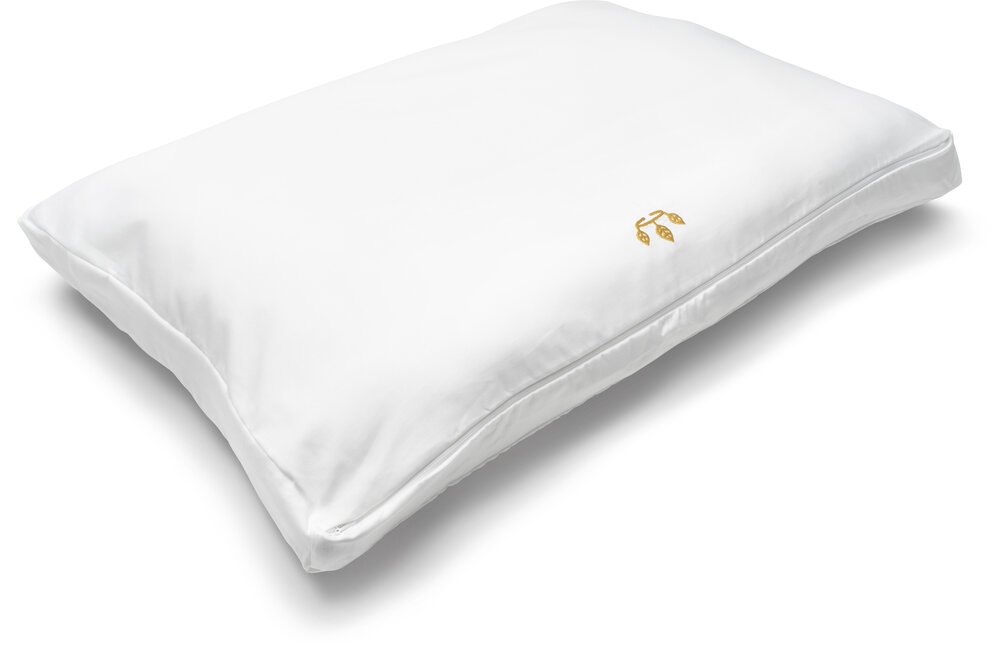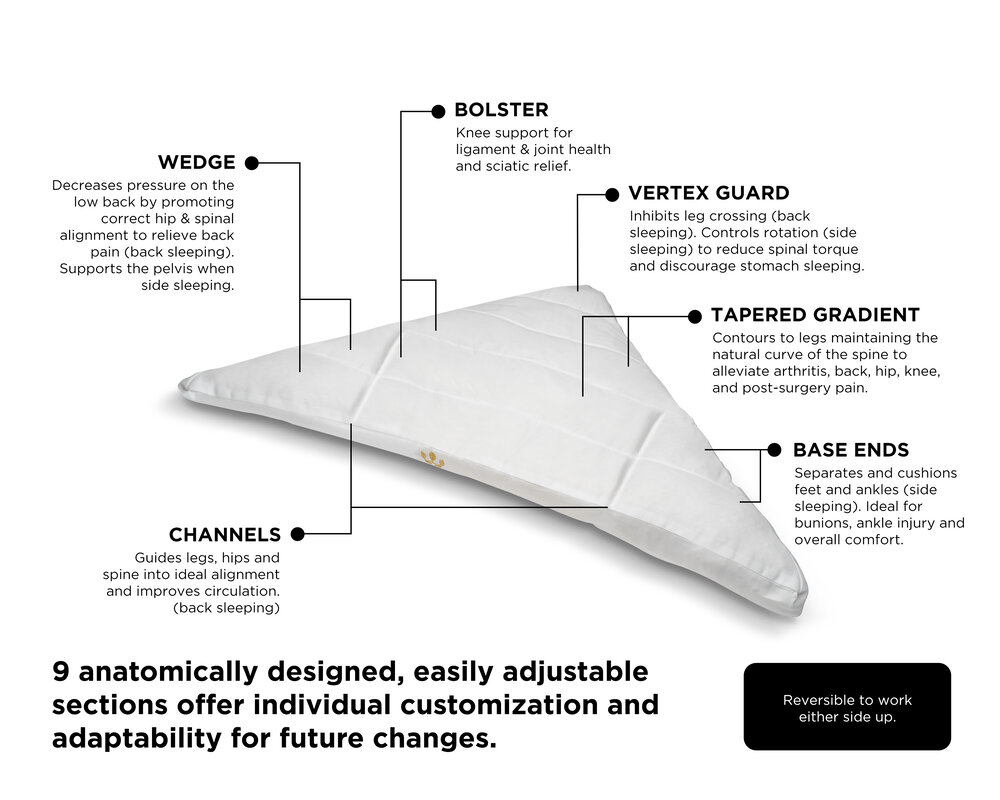Ergonomic, Organic, and Customizable Pillows. Designed for Therapeutic Health & Luxury Comfort.
Adjustable zoned construction with nine anatomically designed sections to adjust to you today and adapt to any future changes you may have in weight, shape, or preference.
Head Pillow


Lower Body Pillow


The right ergonomic pillow can be a lifesaver! If you have ever spent all night tossing and turning for many different reasons, you have probably experienced poor-quality sleep. At some point in our lives, we’ve all experienced poor-quality sleep and woken up feeling more tired than before we went to bed. The American Academy of Sleep Medicine and Sleep Research Society recommends that adults get 7-9 hours of sleep per day, yet about 40% of adults in the US aged 29-59 sleep less than 7 hours per day.
Sleep should leave you rejuvenated and heal your body. During sleep, our brains and bodies get a chance to relax, repair, and reboot before facing another day. Suppose this critical cycle of sleep is interrupted and not executed perfectly. In that case, we end up with poor-quality rest, which has detrimental effects on our physical, emotional, and mental health. One-third of all adults in the US get less than these recommended hours of sleep. As a result, about 75 million American adults chronically suffer from sleep-related disorders.
Lack of quality sleep not only leaves our body with aches and pains, but it also affects productivity and personal finances, causing a substantial economic impact on individuals and society. According to the National Sleep Foundation and Centers for Disease Control and Prevention (CDC), insufficient sleep is a current “public health problem,” A recent 2020 poll shows worsening sleep amongst US adults. To get quality sleep, doctors and other medical professionals recommend ergonomic pillows not only for better sleep but for many other benefits sleep ergonomics offers.
What you should look for in an ergonomic pillow
· Anatomically designed for proper neck support and comfortable regardless of your sleeping position
· Relaxing and superior ergonomics for the lower body
· Not only feels luxurious and high quality but is also safe and chemical-free
· Good ratings and reviews from unbiased sources
· Removable and adjustable filling
What is an ergonomic pillow?
An ergonomic pillow is a pillow designed to complement a sleeper’s natural sleeping position when resting. The pillow cradles the head, neck, and body at all pressure points, conforms to natural body movements, and allows for perfect body alignment while reducing stress on any one part of the body. If used for body positioning while awake, an ergonomic pillow supports posture and promotes comfort leading to less body discomfort, especially when sedentary. The right ergonomic pillow allows for adjustable heights for a perfect fit and offers the proper support in certain medical conditions to promote faster healing. According to the CDC, a comfortable pillow is essential for good quality sleep. There are many good reasons to invest in the right ergonomic pillow, including:
1.Reduce Chronic Morning Headaches
When we think of pillows, the first thought that crosses our mind is a comfortable resting place for our head and neck while sleeping or relaxing. One of the primary functions of every pillow is to provide a comfortable resting position for our head. However, many people do not have a correctly fitted pillow and wake up with frequent morning headaches caused by poor alignment of the neck and head while sleeping. A well-fitted ergonomic pillow will hold your neck and head at the correct position to protect against any stress, strain, or stiffness. National Heart, Lung, and Blood Institute advise that having a comfortable pillow will promote a good night’s sleep and even better if the pillow comes with an organic cover and natural fibers that increase the comfort rating of the pillow.
There are many reasons why we wake up with morning headaches, including snoring, sleep apnea, chronic insomnia, teeth grinding, alcohol, medications, migraines, anxiety, depression, and muscle strain in the neck and scalp. According to Sleep.org, sleeping with the wrong pillow can worsen tension-type headaches in the morning and recommends to “choose a pillow that maintains neutral alignment of the head and neck” to reduce morning headaches. Pillow temperature, often regulated by pillow filling, can also make a difference in how comfortable a pillow is. A pillow filled with an ethically sourced thermoregulator like wool or latex (for vegans or those who prefer a wool alternative) can provide the right temperature and support for the head and neck, reducing the risk of waking up with a morning migraine.
2.Reduce Neck Pain and Improve Neck Support
Next to our head, our neck plays a crucial role in body posture and sleep positioning. The neck is more than what we see on the outside; instead, it is a vast network of bones, muscles, blood vessels, nerves, and other connective tissues. It primarily connects the head to the body and provides support for the skull while still allowing a full range of motion. All information and nutrients from our body must pass through our neck to make it to our head and brains. Given the location of the neck and the critical supportive job it does, it is susceptible to a lot of stress and injuries, including life-threatening ones. About 70% of the population suffer from the consequences of neck pain at some point in their lives; therefore, providing the proper support to the neck, and protecting it at all times, including when resting or sleeping, is especially important.
A good ergonomic pillow will provide the right positioning and support to our neck. It contours to the cervical curvature of the neck, allowing for proper alignment and proper sleep posture while promoting neck healing while at rest or asleep. A correct sleep posture is essential for preventing neck and shoulder pain, and even more recently, sleep ergonomics utilizing pillows are being prescribed as a treatment for chronic neck pain.
Apart from injuries or weakness to our neck due to wear and tear of everyday use, as we age, the spinal discs in our neck naturally degenerate from constant use. One of the most common ailments of age-related disc degeneration is cervical spondylosis, a condition where the disks are dehydrating and shrinking – basically osteoarthritis of the spine. This can be asymptomatic but is also a major cause of chronic neck pain and stiffness. According to recent research, an ergonomic latex pillow can significantly reduce disability symptoms, including pain, in patients with cervical spondylosis.
3.Improve Rotator Cuff Injury Recovery
Rotator cuffs tears are common, painful, and can lead to disability. The rotator cuff is a group of muscles and tendons that keep the ball of the bone of the upper arm (humerus) firmly secured in our shoulder socket. It protects the shoulder joints and allows us a free range of motion over our head so we can do things like comb our hair, play a game of tennis and swim. A rotator cuff injury –tear, irritation, or inflammation– can occur due to wear and tear, lifting something over your head, falling on your arms, or incorrectly lifting a heavy object. This is often very painful, and even though it can get better with surgery, pain relievers, resting of the shoulders, and a combination of heat and ice, there is always a possibility the tear could reoccur.
Studies show that using the right pillow support can reduce tension by up to 56% and reduce the chances of re-tearing, especially when healing. Ergonomic pillows can offer the proper support and significantly reduce pain in the shoulder as well as help with posture. It is often recommended in neck and shoulder rehabilitation and is beneficial in healing and recovery.
4.Helps Reduce Snoring and Improve Breathing
About 90 million Americans suffer from snoring, according to the American Sleep Apnea Association. Even though snoring can be indicative of a serious medical condition known as Obstructive Sleep Apnea (OSA) and should be treated by a medical practitioner, most snoring is often less serious and can be treated with lifestyle modifications. Snoring occurs when the tissues in the back of the nose relax during sleep and partially block the airways. As air is inhaled, it rattles the tissue as it flows past to cause the distinct snoring sound most of us recognize. Any condition that can cause narrowing or inflammation of airways can lead to snoring, including allergies, deviated septum, enlarged tonsils, enlarged adenoids, increasing age, extra weight, alcohol, and smoking.
Regardless of the cause, snoring adversely affects sleep quality – both for the snorer and anyone sleeping next to them. Lack of consistent, high-quality sleep can lead to severe medical conditions, including heart disease and diabetes. For many people snoring is affected by sleep position. Although there are no easy treatments for snoring, lifestyle changes like adjusting our sleeping position and using an ergonomic pillow can provide some tremendous benefits, including reducing snoring and breathing better and easier. According to the Sleep Foundation, lifting the head and neck with the right pillow can allow the throat muscles to relax without blocking the airway, thus making gravity work in the sleeper’s favor. Elevating the bed with the right pillow can also help.
5.Reduce Lower Back and Hip Pain
The back is made up of bones, spinal discs, joints, muscles, and ligaments. When the function of any of these structures is disrupted –pulling a muscle, irritating a joint, spraining a ligament, rupturing a disc– back pain can occur. Back pain can also occur due to surgeries like hip replacement, age-related changes to our lower spine, damage to the discs in the lower spine, back injury, repetitive motion, or compression to the nerves in the back. Back pain can also be linked to sciatica, a tingling, burning, or stabbing pain that starts from the lower back and extends through the legs, caused by damage to the sciatic nerve in the back. Regardless of the origin of the back pain, the result is the same, poor quality sleep and back pain. According to the American Chiropractic Association (ACA), back pain is the single leading cause of disability that prevents people from engaging in everyday activities, including work and play.
Back pain is the third most common reason why people visit a doctor. Over 80% of people will experience back pain at some point in their lifetime. Most people with back pain can recover with rest and the proper treatment, but for others, back pain can become chronic. Treatment can vary from pain medications and surgery to simple non-invasive lifestyle modifications like using a supportive lower body pillow to reduce pain in the mid-back, lower back, hips, and knees. The right ergonomic pillow can also improve pain and facilitate recovery for specific medical procedures such as hip replacement.
6.Correct Postural Problems
While sitting, walking, and just moving around, we often do not always keep good posture. However, during rest or sleep, our body aims to restore all the damage done to our posture while awake and active. High-quality and restorative sleep allows the body to heal from postural damage as well as other physical injuries to the body. An ergonomic pillow is not only comforting and luxurious, but it also plays a significant role in keeping the upper body in proper alignment during sleep and alleviates pressure points in the body.
A common problem that sometimes arises from sleep positioning sleep quality, and postural problems is TMJ (temporomandibular joint) pain. This condition results when the bite of the jaw is misaligned. This causes wear and tear on the muscles of the jawbone leading to severe pain, discomfort, headaches, and earaches. An ergonomic pillow, though not a cure, can help provide just the right amount of support for the face, head, and upper body to reduce the risk of TMJ pain. Too much or too little support can have a negative impact on TMJ pain.
It’s worth knowing that not all ergonomic pillows are made equal, and the shape of the pillow, as well as the filling, can make a huge difference to the level of support and correction a pillow can offer. The right designed and shaped pillow is natural and adjusts to fit a sleeper’s unique curve, shape, and sleeping position while providing support for the head, neck, shoulders, back, hip, and spine. If the pillow is too low, the neck muscles can be strained. If the pillow is too high, the neck can be misaligned and lead to straining of the shoulders and neck muscles.
7.Upper & Lower Body Support
An ergonomic pillow, sometimes in a combination of upper/head and lower body pillows, offers full-body support regardless of how you sleep. The pillow should be designed to cradle the head and provide support for the neck and the whole body, including the knees, hips, and back. It should be comfortable enough to allow for normal sleep – when you fall asleep easier and stay asleep longer. If you are a back sleeper, the right pillow will support the natural curvature of your spine as well as your head, neck, and shoulders. It should position the head properly to open up the airways and reduce snoring. If you are a side sleeper, the right pillow should support your head and neck to maintain a neutral spine. The best-performing pillow should account for differences in shoulder sizes to reduce neck and shoulder stress and reduce the risk of muscle strain and tension. For those who sleep on their stomach, an ergonomic pillow, adjusted with the right filling, will allow the body to rest almost flat while ensuring the head and neck remain unstrained. This keeps the spine and lower back aligned naturally.
A lower body pillow can also support the lower back, knees, legs, feet, ankles and allow positioning of the pelvis and spine in a proper alignment, thus preventing rotation of the body, especially in conditions where back sleeping and stomach sleeping is not medically advisable. A lower body pillow also reduces pain in the back, hips, and knees and allows the entire body to heal better when resting normally or recovering post-surgery. For the combination sleepers who naturally sleep on their sides, back, and stomach, ergonomic pillows or a combination of pillows that offer an upper body/head pillow as well as lower body support can help provide full-body support while keeping the body aligned for a high quality sleep.
8.Reduce the Risk of Chronic Diseases
Sleep is the foundation for good mental, emotional, and physical health. The American Academy of Sleep Medicine and the National Sleep Foundation recommend that adults 18-60 need at least 7 hours of good quality sleep per night to promote general health and wellness. Sleep quality refers to how well you sleep. The way we feel when we wake up is a direct relationship with how well we slept. Good quality sleep means you can fall asleep in less than 30 minutes, go back to sleep within 20 minutes if awakened, and sleep through the hours without more than one awakening. In addition, a good quality sleep should be free of sleep disorders likes snoring, insomnia (inability to initiate and maintain sleep), restless leg syndrome (aches and pains in legs), sleep apnea (gasping for air while sleeping), and pain in any part of the body including head, neck, shoulders, back, and hips.
According to the Centers for Disease Control and Prevention (CDC), sleeping less than 7 hours per day, and poor quality sleep when resting, is associated with devastating chronic diseases including anxiety, depression, heart disease, stroke, high blood pressure, obesity, chronic fatigue, diabetes, memory deficits, performance deficits, and overall, shortened lifespan. People who are not well-rested are more prone to accidents and poor decision-making. The right ergonomic pillow, through the multiple benefits it offers, can help promote long and restful sleep. Good quality sleep reduces our chances of getting sick often, reduces stress, improves our mood, and helps us avoid injuries, especially car accidents. Good sleep allows us to make better decisions as well as improving our relationship with those around us. Good sleep is essential for our mental, physical, and emotional health and wellness.
